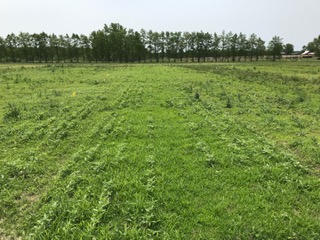
Heavy weed competition and poor stand establishment in fiber hemp plots planted on May 15th at Meigs farm
With large amounts of rain across the state during the month of May, farmers have struggled to plant hemp this season. There is also the threat of increased weed pressure and seedling diseases for anybody that manages to get seeds in the ground. From four years of hemp research at Purdue, we can attest that hemp does not like wet feet.
Hemp is not a miracle crop, especially when we have very wet spring weather. Controlling for weeds and pathogens is challenging because there are no pesticides labeled for use in hemp (including OMRI listed pesticides). Having a clean seedbed prior to planting can help reduce weed pressure, as well as a higher seeding rate and tighter row widths (Vera et al. 2006). Weed control is crucial during the first 3-4 weeks of growth until hemp becomes more competitive once canopy closure occurs.
There are multiple pathogens affecting hemp seedlings including damping off diseases caused by water molds (Chromista), Pythium species (P. aphanidermatum and P. ultimum), and several other fungal species (Beckerman et al. 2017; McPartland 1996b; McPartland and McKernan 2017). Saturated and compacted soils are the perfect combination to foster diseases that affect stand establishment.
While hemp production in the state is still minimal compared with corn and soy, approximately 4,000 acres were registered for hemp production in 2019. We predict hemp acreage could triple next year. A lot is at stake for this re-emerging crop as farmers look to diversify, however, there is a lack of established guidelines for production and pest management. Because our knowledge of production is limited, and we cannot apply pesticides, hemp poses economic risks, especially when we have a very wet spring. For anybody interested in hemp production, have a solid plan for planting, managing, harvesting, and selling your crop.
Related References
Purdue Hemp Website. https://dev.purduehemp.org/hemp-production/
Beckerman J, Nisonson H, Albright N, and Creswell T. 2017. First Report of Pythium aphanidermatum crown and root rot of industrial hemp in the United States. Plant Disease 101: 1038-1039.
McPartland JM. 1996b. A review of Cannabis diseases. J. Int. Hemp Assoc. 3, 19–23.
McPartland JM, McKernan KJ, 2017. In: Chandra S, Lata H, ElSohly M. (Eds.) Contaminants of Concern in Cannabis: Microbes, Heavy Metals and Pesticides. Springer International Publishing, pp. 457–474.
Vera CL, Woods SM, and Raney JP. 2006. Seeding rate and row spacing effect on weed competition, yield and quality of hemp in the Parkland region of Saskatchewan. Canadian Journal of Plant Science 86: 911-915.


